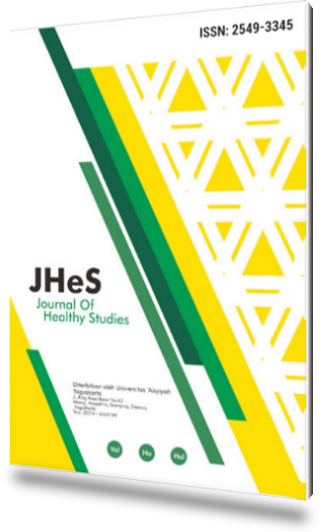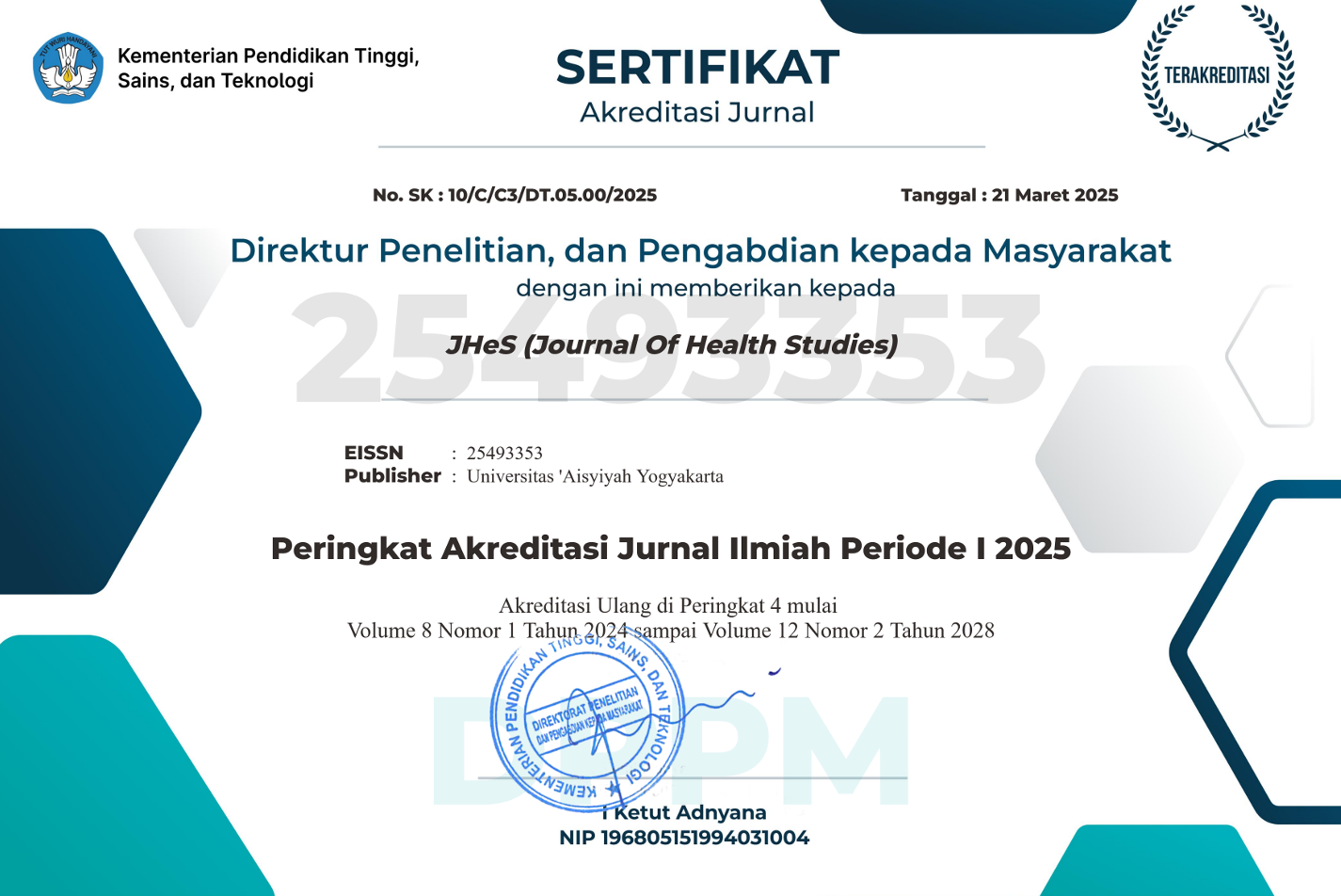Implementasi of technology acceptance model (TAM) in electronic documentation of nursing care: phenomenology explorative
DOI:
https://doi.org/10.31101/jhes.3052Abstract views 768 times
Keywords:
computer self-efficacy, nursing care documentation, technology acceptance model implementationAbstract
Downloads
References
Abdekhoda, M., Dehnad, A., & Zarei, J. (2019). Determinant factors in applying electronic medical records in healthcare. Eastern Mediterranean Health Journal, 25(1), 24–33. https://doi.org/10.26719/emhj.18.007
Afrizal, S. H., Hidayanto, A. N., Handayani, P. W., Budiharsana, M., & Eryando, T. (2019). Narrative Review for Exploring Barriers to Readiness of Electronic Health Record Implementation in Primary Health Care. Healthcare Informatics Research, 25(3), 141–152. https://doi.org/10.4258/hir.2019.25.3.141
Ahmed, M. H., Bogale, A. D., Tilahun, B., Kalayou, M. H., Klein, J., Mengiste, S. A., & Endehabtu, B. F. (2020). Intention to use electronic medical record and its predictors among health care providers at referral hospitals, north-West Ethiopia, 2019: Using the unified theory of acceptance and use technology 2(UTAUT2) model. BMC Medical Informatics and Decision Making, 20(1), 207. https://doi.org/10.1186/s12911-020-01222-x
Alanazi, H. O., Zaidan, A. A., Zaidan, B. B., Kiah, M. L. M., & Al-Bakri, S. H. (2015). Meeting the Security Requirements of Electronic Medical Records in the ERA of High-Speed Computing. Journal of Medical Systems, 39(1), 165. https://doi.org/10.1007/s10916-014-0165-3
Aldosari, B., Al-Mansour, S., Aldosari, H., & Alanazi, A. (2018). Assessment of factors influencing nurses' acceptance of electronic medical record in a Saudi Arabia hospital. Informatics in Medicine Unlocked, 10, 82–88. https://doi.org/10.1016/j.imu.2017.12.007
Almarzouqi, A., Aburayya, A., & Salloum, S. A. (2022). Determinants predicting the electronic medical record adoption in healthcare: A SEM-Artificial Neural Network approach. PLOS ONE, 17(8), e0272735. https://doi.org/10.1371/journal.pone.0272735
Arikan, F., Kara, H., Erdogan, E., & Ulker, F. (2021). Barriers to Adoption of Electronic Health Record Systems from the Perspective of Nurses: A Cross-sectional Study. Computers, Informatics, Nursing: CIN, 40(4), 236–243. https://doi.org/10.1097/CIN.0000000000000848
Atasoy, H., Greenwood, B. N., & McCullough, J. S. (2019). The Digitization of Patient Care: A Review of the Effects of Electronic Health Records on Health Care Quality and Utilization. Annual Review of Public Health, 40, 487–500. https://doi.org/10.1146/annurev-publhealth-040218-044206
Balestra, M. L. (2017). Electronic Health Records: Patient Care and Ethical and Legal Implications for Nurse Practitioners. The Journal for Nurse Practitioners, 13(2), 105–111. https://doi.org/10.1016/j.nurpra.2016.09.010
Budiarto, R. (2017). Analisis faktor adopsi aplikasi mobile berdasarkan pengalaman, usia dan jenis kelamin menggunakan UTAUT2. Register: Jurnal Ilmiah Teknologi Sistem Informasi, 3(2), 114-126.
Cho, Y., Kim, M., & Choi, M. (2021). Factors associated with nurses’ user resistance to change of electronic health record systems. BMC Medical Informatics and Decision Making, 21(1), 218. https://doi.org/10.1186/s12911-021-01581-z
Chow, M., Chan, L., Lo, B., Chu, W.-P., Chan, T., & Lai, Y.-M. (2013). Exploring the intention to use a clinical imaging portal for enhancing healthcare education. Nurse Education Today, 33(6), 655–662. https://doi.org/10.1016/j.nedt.2012.01.009
Dehling, T., & Sunyaev, A. (2014). Secure provision of patient-centered health information technology services in public networks—Leveraging security and privacy features provided by the German nationwide health information technology infrastructure. Electronic Markets, 24(2), 89–99. https://doi.org/10.1007/s12525-013-0150-6
Durodolu, O. O. (2016). Technology Acceptance Model as a predictor of using information system’ to acquire information literacy skills. Library Philosophy and Practice (e-Journal).
Dwisatyadini, M., Hariyati, R. T. S., & Afifah, E. (2018). The effects of the application of SIMPRO on the completeness and time efficiency of nursing documentation in the outpatient instalation at Dompet Dhuafa Hospital Parung. IOP Conference Series: Materials Science and Engineering, 332, 012034. https://doi.org/10.1088/1757-899X/332/1/012034
Firdaus, M. (2020). Improving Patient Safety and Hospital Service Quality Through Electronic Medical Record: A Systematic Review. Jurnal Administrasi Rumah Sakit Indonesia, 6(1), Article 1. https://doi.org/10.7454/arsi.v6i1.2880
Gesulga, J. M., Berjame, A., Moquiala, K. S., & Galido, A. (2017). Barriers to Electronic Health Record System Implementation and Information Systems Resources: A Structured Review. Procedia Computer Science, 124, 544–551. https://doi.org/10.1016/j.procs.2017.12.188
Gunawan, H. (2018). Analisis Pengaruh Gender Dalam Penerimaan Teknologi “Smart City†Dengan Model Technology Acceptance Model (TAM).
Jawhari, B., Keenan, L., Zakus, D., Ludwick, D., Isaac, A., Saleh, A., & Hayward, R. (2016). Barriers and facilitators to Electronic Medical Record (EMR) use in an urban slum. International Journal of Medical Informatics, 94, 246–254. https://doi.org/10.1016/j.ijmedinf.2016.07.015
Jedwab, R. M., Manias, E., Hutchinson, A. M., Dobroff, N., & Redley, B. (2022a). Nurses’ Experiences After Implementation of an Organization-Wide Electronic Medical Record: Qualitative Descriptive Study. JMIR Nursing, 5(1), e39596. https://doi.org/10.2196/39596
Jedwab, R. M., Manias, E., Hutchinson, A. M., Dobroff, N., & Redley, B. (2022b). Understanding nurses’ perceptions of barriers and enablers to use of a new electronic medical record system in Australia: A qualitative study. International Journal of Medical Informatics, 158, 104654. https://doi.org/10.1016/j.ijmedinf.2021.104654
Kalayou, M. H., Endehabtu, B. F., & Tilahun, B. (2020). The Applicability of the Modified Technology Acceptance Model (TAM) on the Sustainable Adoption of eHealth Systems in Resource-Limited Settings. Journal of Multidisciplinary Healthcare, 13, 1827–1837. https://doi.org/10.2147/JMDH.S284973
Keshta, I., & Odeh, A. (2021). Security and privacy of electronic health records: Concerns and challenges. Egyptian Informatics Journal, 22(2), 177–183. https://doi.org/10.1016/j.eij.2020.07.003
Kinanti, F. S. (2021). Evaluasi penggunaan sistem informasi manajemen keperawatan di rs jiwa grhasia daerah istimewa yogyakarta. Journal of Information Systems for Public Health, 5(3), Article 3. https://doi.org/10.22146/jisph.43831
Kruse, C. S., Smith, B., Vanderlinden, H., & Nealand, A. (2017). Security Techniques for the Electronic Health Records. Journal of Medical Systems, 41(8), 127. https://doi.org/10.1007/s10916-017-0778-4
Mahalli, A. El. (2015). Adoption and Barriers to Adoption of Electronic Health Records by Nurses in Three Governmental Hospitals in Eastern Province, Saudi Arabia. Perspectives in Health Information Management, 12(Fall), 1f.
Manca, D. P. (2015). Do electronic medical records improve quality of care? Canadian Family Physician, 61(10), 846–847.
Marthen, S., Fery Agusman Motuho Mendrofa, F., & Susi, N. (2022). Rancangan Desain Dokumentasi Asuhan Keperawatan SDKI, SLKI, SIKI Dalam Meningkatkan Kepuasan Pelayanan di Rumah Sakit. Universitas Karya Husada Semarang. http://eprints.unkaha.ac.id/467/
McCarthy, B., Fitzgerald, S., O’Shea, M., Condon, C., Hartnett-Collins, G., Clancy, M., Sheehy, A., Denieffe, S., Bergin, M., & Savage, E. (2019). Electronic nursing documentation interventions to promote or improve patient safety and quality care: A systematic review. Journal of Nursing Management, 27(3), 491–501. https://doi.org/10.1111/jonm.12727
Mohammadi Firouzeh, M., Jafarjalal, E., Emamzadeh Ghasemi, H. S., Bahrani, N., & Sardashti, S. (2017). Evaluation of vocal-electronic nursing documentation: A comparison study in Iran. Informatics for Health & Social Care, 42(3), 250–260. https://doi.org/10.1080/17538157.2016.1178119
Muinga, N., Magare, S., Monda, J., English, M., Fraser, H., Powell, J., & Paton, C. (2020). Digital health Systems in Kenyan Public Hospitals: A mixed-methods survey. BMC Medical Informatics and Decision Making, 20, 2. https://doi.org/10.1186/s12911-019-1005-7
Murphy, D. R., Satterly, T., Rogith, D., Sittig, D. F., & Singh, H. (2019). Barriers and facilitators impacting reliability of the electronic health record-facilitated total testing process. International Journal of Medical Informatics, 127, 102–108. https://doi.org/10.1016/j.ijmedinf.2019.04.004
Ologeanu-Taddei, R., Morquin, D., Domingo, H., & Bourret, R. (2015). Understanding the acceptance factors of an Hospital Information System: Evidence from a French University Hospital. AMIA Annual Symposium Proceedings, 2015, 1001–1007.
Pratami, S. W. (2018). Pengaruh Faktor Persepsi, Sosial-Demografi dan Keuangan terhadap Preferensi Masyarakat Dalam Penggunaan Alat Pembayaran Non Tunai (Studi Kasus pada Pengguna APMK dan Uang Elektronik di Kota Malang). Jurnal Ilmiah Mahasiswa FEB, 7(1).
Shosha, G. A. (2012). EMPLOYMENT OF COLAIZZI’S STRATEGY IN DESCRIPTIVE PHENOMENOLOGY: A REFLECTION OF A RESEARCHER. European Scientific Journal, 8. https://doi.org/10.19044/esj.2012.v8n27p
Supriyati, S., & Cholil, M. (2017). Aplikasi Technology Acceptance Model pada Sistem Informasi Manajemen Rumah Sakit. Jurnal Bisnis dan Manajemen (Journal of Business and Management), 17(1), 81–102. https://doi.org/10.20961/jbm.v17i1.12308
Surendran, P. (2012). Technology Acceptance Model: A Survey of Literature. International Journal of Business and Social Research.
Taherdoost, H. (2019). Importance of Technology Acceptance Assessment for Successful Implementation and Development of New Technologies. Global Journal of Engineering Sciences, 1. https://doi.org/10.33552/GJES.2019.01.000511
Tertulino, R., Antunes, N., & Morais, H. (2023). Privacy in electronic health records: A systematic mapping study. Journal of Public Health. https://doi.org/10.1007/s10389-022-01795-z
Tsai, C. H., Eghdam, A., Davoody, N., Wright, G., Flowerday, S., & Koch, S. (2020). Effects of Electronic Health Record Implementation and Barriers to Adoption and Use: A Scoping Review and Qualitative Analysis of the Content. Life (Basel, Switzerland), 10(12), 327. https://doi.org/10.3390/life10120327
Tubaishat, A. (2018). Perceived usefulness and perceived ease of use of electronic health records among nurses: Application of Technology Acceptance Model. Informatics for Health and Social Care, 43(4), 379–389. https://doi.org/10.1080/17538157.2017.1363761
Tubaishat, A. (2019). The effect of electronic health records on patient safety: A qualitative exploratory study. Informatics for Health & Social Care, 44(1), 79–91. https://doi.org/10.1080/17538157.2017.1398753
Wirihana, L., Welch, A., Williamson, M., Christensen, M., Bakon, S., & Craft, J. (2018). Using Colaizzi’s method of data analysis to explore the experiences of nurse academics teaching on satellite campuses. Nurse Researcher, 25(4), 30–34. https://doi.org/10.7748/nr.2018.e1516
Zaman, N., Goldberg, D. M., Kelly, S., Russell, R. S., & Drye, S. L. (2021). The Relationship between Nurses’ Training and Perceptions of Electronic Documentation Systems. Nursing Reports, 11(1), 12–27. https://doi.org/10.3390/nursrep11010002
Downloads
Additional Files
Published
Issue
Section
License
Copyright (c) 2023 JHeS (Journal of Health Studies)

This work is licensed under a Creative Commons Attribution-ShareAlike 4.0 International License.
With the receipt of the article by the Journal of Health Studies Editorial Board and the decision to be published, then the copyright regarding the article will be diverted to Journal of Health Studies. Universitas 'Aisyiyah Yogyakarta as the publisher of Journal of Health Studies hold the copyright regarding all the published articles in this journal.
Journal of Health Studies is licensed under a Creative Commons Attribution-ShareAlike 4.0 International License.














